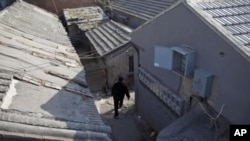Hutongs are a traditional form of architecture in Beijing that once dominated the city, but are now found mostly near the Forbidden City in the heart of the Chinese capital.
But China’s economic boom, as well as the decaying nature of many of the structures, have made the hutongs, with their central location, prime candidates for destruction. “A hutong is actually an alley, however the meaning is much greater than a physical space,” said Beijing-based American filmmaker Jonah Kessel. “In Beijing, and China, it kind of refers to a way of life, almost a communal atmosphere.”
Kessel decided to make a documentary about the decline of the hutongs. “I moved into the neighborhood where the issue exists, so it was in front of my face before I actually went full-forward with the project,” said Kessel.
The result is “The Fate of Old Beijing,” a documentary exploring the city’s hutongs. “It is a complicated issue,” said Kessel. “They are incredibly old structures and they haven’t been maintained, the people who have been living in them for extremely long periods of time, family after family, generations, haven’t had money to actually modernize them and take care of them.”
Many of Beijing’s hutongs date back to the 13th century. During the Cultural Revolution, the hutongs were divided, and many more people crowded into the traditional courtyards. The residents use communal bathrooms and some share kitchens.
The narrow and contained nature of the hutongs also creates health concerns. “Most of these alleys are very small, you can’t put an ambulance down [them], let alone a big truck,” said Kessel. “With the car boom in China that happened over the past 10 years, there’s more and more cars in these alleys, it’s actually hurting the alleys even more, so a lot of them are really in poor shape.”
When the hutongs are destroyed, the longtime occupants must be relocated. Residents are informed that their hutong will be demolished in six months, a year or two years, and then they have to find new accommodations. Sometimes the demolition is postponed. But the effort to find new living quarters is challenging, considering Beijing’s soaring real estate costs.
“The people who do get relocated are compensated per square meter of their house to an adjusted value that was set a long time ago and hasn’t really changed,” said Kessel. “Back in 1995, when these people were given a settlement, it might have been enough to get them a nice apartment…however that value now is nothing compared to the relative value 10 or 15 years ago.”
According to Kessel, many of the people forced to move from hutongs in the center of Beijing are now in the outskirts of the city, where they are living in impersonal high-rise buildings and do not know their neighbors. These residents sometimes miss the communal nature of the hutongs, but they do not have to venture outdoors in the winter weather to use bathrooms.
There are architectural conservationists in Beijing who are trying to protect the hutongs, such as the Beijing Cultural Heritage Protection Center. Some of the ancient structures have been restored, and are popular tourist stops for both domestic and foreign visitors. But such gentrification also poses a problem, according to Jonah Kessel.
“A lot of hutongs do get remade, and they’ll knock them all down and put them back up, and they’ll make them look old but beautiful in the Disney kind of way,” he said. “And a lot of the people who do live here hate that, they think it looks fake, they think it looks hollow, and at the same time, it does draw tourists.”
No matter what happens to the hutongs, their place in China’s cultural history remains firm. But preservationists hope that Beijing’s traditional structures remain more than a memory.





